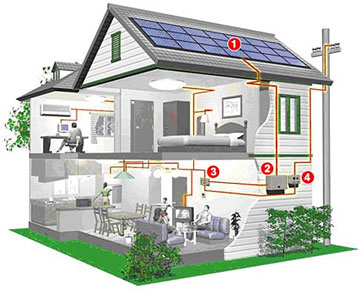
What is photovoltaics ?
Photovoltaics is the technology producing electric energy from solar radiation.
Photovoltaic systems do not require direct solar radiation for their operation. They are capable of electricity production also when it is cloudy.
Direct transformation of solar radiation to electric energy is possible thanks to the use of semiconductor materials, silicon being currently the most frequently used one.
Photovoltaic power station on your own roof
The construction of a photovoltaic power station on one´s own roof is one of the most interesting investments nowadays.
Save the input costs, the energy would not cost you anything and its return rate is 7 to 9 years, while the operation life of the panels ranges from 20 to 35 years.
Photovoltaic cells, modules and fields
 Photovoltaic cells are also called solar cells. The thin layer of semiconductor wafers for solar cells is specially treated in order to generate electric field, positive at one side and negative at the other side.
Photovoltaic cells are also called solar cells. The thin layer of semiconductor wafers for solar cells is specially treated in order to generate electric field, positive at one side and negative at the other side.
When the energy of light impacts the solar cells, free electrons are released from semiconductor material atoms. When the electric wires are connected to positive and negative sides forming the electric circuit, the electrons may be entrapped in the form of electricity.
Several electrically interconnected solar cells fixed to the supporting structure or frame is called a photovoltaic module. The modules are designed so that they would be able to deliver electric energy at a certain voltage, such as the common 12 Volts. The quantity of produced current directly depends upon the quantity of light impacting the module.
Several modules may be interconnected in order to form fields. In general, the greater is the area of the module or field, the more electricity shall be produced.
Photovoltaic modules and fields produce direct current (DC). They may be connected in series or parallel-connected in order to produce the required voltage and current combination.
Light energy is transformed to electricity in the photovoltaic module. The photovoltaic module is the basic element of every photovoltaic system. It is composed of several interconnected photovoltaic (solar) cells.
Photovoltaic module power
The power of typical crystalline modules ranges from several W up to 200 W per module.
Some producers produce pre-assembled panels of several 100 Wp. The photovoltaic module shall produce much more electricity during its estimated operation life than they consume when producing it.
100 W module shall save the emission of more than two tons of CO2.

 Photovoltaic cells are also called solar cells. The thin layer of semiconductor wafers for solar cells is specially treated in order to generate electric field, positive at one side and negative at the other side.
Photovoltaic cells are also called solar cells. The thin layer of semiconductor wafers for solar cells is specially treated in order to generate electric field, positive at one side and negative at the other side.